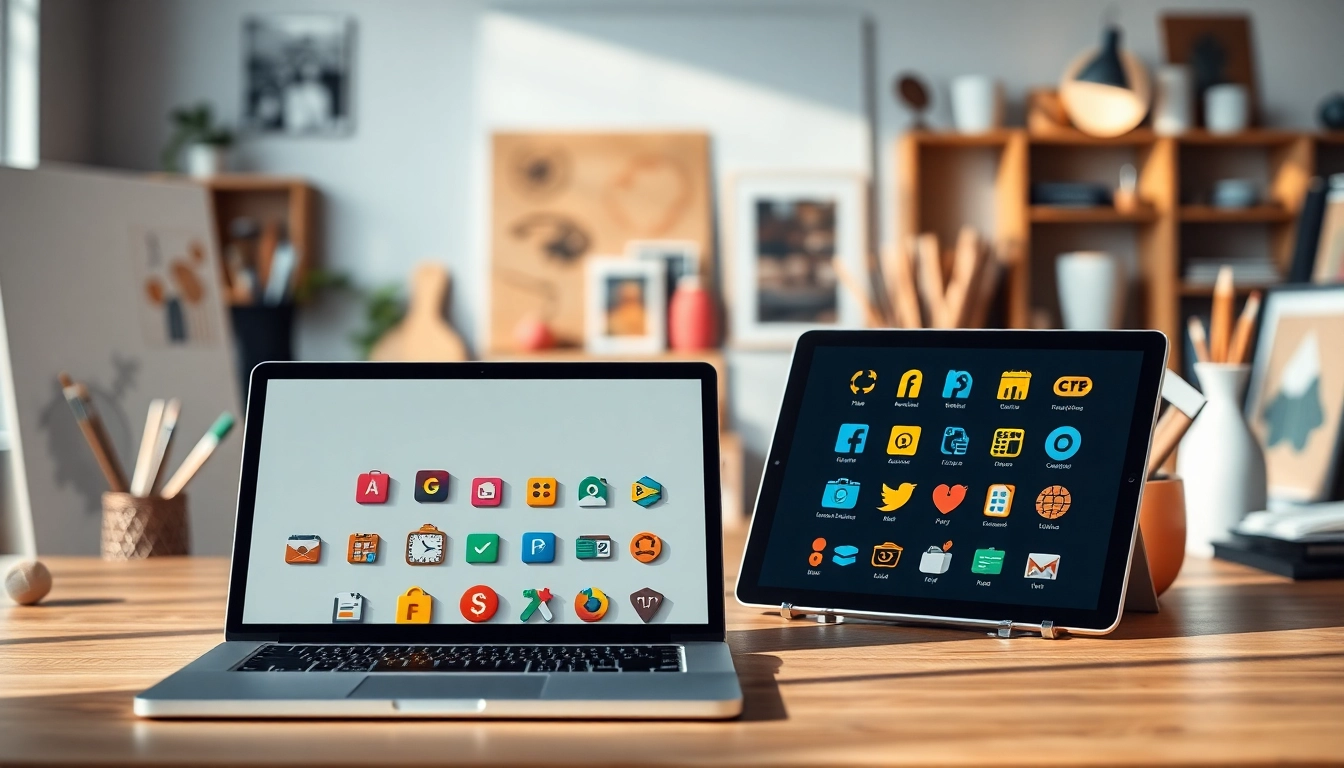Understanding the Role of Icons in Design
Icons serve as essential visual language in digital design, acting as symbols that communicate ideas, actions, and functionalities at a glance. Their usage transcends traditional imagery, offering an intuitive interface experience for users. Whether it’s a small graphic representing a folder, heart, or a settings gear, icons simplify complex information, allowing users to engage with interfaces quickly and efficiently. Understanding the pivotal role of icons can greatly enhance user experience and drive engagement in digital projects. For a deeper understanding, you can explore the wide variety of Icons available.
What are Icons and Their Importance?
Icons are graphical representations that symbolize actions, concepts, or objects in a concise manner. The importance of icons in design cannot be overstated—they are fundamental elements that improve usability, enhance visual appeal, and facilitate effective communication with users. Here are several reasons why icons are crucial:
- Visual Recognition: Icons can be easily recognized and understood across different languages and cultures, making them universally comprehensible.
- Space Efficiency: Instead of lengthy text, icons convey messages succinctly, which is particularly beneficial in limited screen real estate.
- Enhanced User Experience: Well-designed icons lead to intuitive navigation and can significantly reduce frustration by guiding users smoothly through interactions.
- Brand Identity: Unique icons can reinforce a brand’s identity, offering a recognizable look and feel that differentiates it from competitors.
Types of Icons: A Quick Overview
Icons can be categorized into several types, each serving distinct purposes in design. Here’s a quick overview:
- Action Icons: Icons that represent actions, such as a trash bin or a pencil for editing.
- Navigation Icons: Icons used in menus, like arrows indicating directions or home symbols that guide users back to the main page.
- Social Media Icons: Icons representing various social media platforms, commonly visible on websites and applications.
- Indicator Icons: Icons that present status or alerts, for example, battery indicators or notifications.
Common Usage Scenarios for Icons
Icons find application in various scenarios, including:
- Web Design: Navigation menus, buttons, and links often incorporate icons to enhance the user interface.
- Mobile Applications: Icons dominate the mobile app sphere, where screen space is at a premium.
- Marketing Materials: Icons in brochures, advertisements, and other media can visually summarize key points.
- User Interface Components: Components like sliders or accordion menus frequently utilize icons for clarity.
Design Principles for Creating Memorable Icons
Key Characteristics of Effective Icons
Creating memorable icons requires adherence to key design principles:
- Clarity: Icons should convey their meaning instantly and clearly, without causing confusion.
- Consistency: Icons used within a project should maintain a cohesive style and color scheme.
- Simplicity: An effective icon often embodies a minimalist approach, eschewing unnecessary details that can clutter its visual message.
- Scalability: Icons should be designed to retain clarity and recognizability at various sizes.
Color Psychology and Icon Design
The application of color in icon design has far-reaching impacts on user perception. Colors evoke emotional responses and can further reinforce the message an icon is trying to convey. Here are some common associations:
- Red: Often denotes urgency or warnings.
- Green: Associated with safety or eco-friendliness.
- Blue: Conveys trust and reliability.
- Yellow: Can signify optimism or caution.
Choosing the Right Style for Your Icons
The style of icons can greatly influence the overall design aesthetic. Key styles include:
- Flat Design: Featuring minimalistic and two-dimensional elements, flat icons are widely favored for their simplicity.
- Line Icons: Thin outlines without color fill present an elegant and modern appearance.
- Filled Icons: These can evoke a sense of depth and provide a more tactile feeling than flat or line icons.
- 3D Icons: Offering a more dynamic look, 3D icons can draw attention but may also distract if not used sparingly.
Tools and Resources for Icon Creation
Popular Software for Designing Icons
A plethora of software options are available for creating icons, allowing designers of all expertise levels to turn their ideas into visual realities. Popular choices include:
- Adobe Illustrator: A vector graphics editor ideal for designing icons from scratch.
- Sketch: A design toolkit tailored for creating perfect digital products with vector graphics.
- Figma: A collaborative interface design application great for teams to work together on icon design.
- Affinity Designer: A cost-effective alternative to Adobe, it offers powerful vector design tools.
Free and Paid Resources for Icons
Whether you need a single icon or a comprehensive icon set, various resources are at your disposal:
- Flaticon: Offers an extensive library of free and premium icons available in multiple formats.
- The Noun Project: A popular platform for finding high-quality icons to suit diverse design needs.
- Icons8: Provides both free and premium icons with a consistent design style across the collection.
- Material Icons: A comprehensive icon set designed by Google, showcasing over 2,000 customizable icons.
Utilizing Online Icon Libraries Effectively
When integrating icons from online libraries into your project, consider the following best practices:
- Maintain Consistency: Choose icons from the same library to ensure uniformity in design elements.
- Customize Them: Don’t hesitate to modify icons to better fit your brand identity or design requirements.
- Check Licensing: Ensure you understand the usage rights and limitations of any icons you download.
- Optimize Sizes: Always use the right size for your icons to prevent pixelation or blurriness in your design.
Optimizing Icons for User Experience
Best Practices for Icon Size and Placement
The sizing and placement of icons are critical to ensuring they enhance rather than hinder the user experience. Here are key considerations:
- Size: Icons should be easily tappable on mobile devices; a minimum size of 44×44 pixels is recommended.
- Spacing: Adequate spacing between icons helps improve accessibility and prevents confusion for users.
- Placement: Positioning icons where users expect to find them can lead to seamless navigation.
Accessibility Considerations for Icons
When designing icons, it’s crucial to consider accessibility for all users, including those with disabilities. Implement these guidelines:
- Use Descriptive Alt Text: Providing alternative text for icons ensures screen readers can convey their meanings to visually impaired users.
- Color Contrast: Ensure there is enough contrast between icons and background colors to make them distinguishable.
- Tooltips: Implement tooltips to offer additional context for icons when users hover over them.
Testing Icon Effectiveness: Metrics and Feedback
To gauge the effectiveness of icons, employ various testing methods and metrics:
- User Feedback: Gathering input from users on icon usability can provide invaluable insights for refinements.
- A/B Testing: Experimenting with different icon styles or placements can illuminate which performs better with your target audience.
- Engagement Analytics: Monitoring click-through rates or interaction times can help assess the effectiveness of your icons in guiding user actions.
Future Trends in Icon Design
The Rise of Animated and Interactive Icons
As technology evolves, so does the design landscape. Animate and interactive icons are gaining popularity, allowing for engagement beyond static visuals. These elements can:
- Enhance User Engagement: Animated icons can attract attention and guide users through actions.
- Provide Feedback: Interactive icons can indicate state changes (for instance, when a button is pressed).
- Appeal to Emotions: Well-crafted animations can evoke positive user emotions and connection with the content.
Sustainability and Eco-Friendly Icon Design
The growing emphasis on sustainability is influencing icon design, prompting designers to consider their environmental impact. This includes:
- Reducing Digital Waste: Designers should strive for simplicity, minimizing digital clutter with streamlined icon sets.
- Energy Efficiency: Icons that load quickly reduce energy consumption across various devices.
- Promoting Eco-Friendly Values: The use of natural elements or green colors in icon design can communicate commitment to sustainability.
Integrating Technology Innovations into Icon Design
Advancements in technology continuously shape the future of icon design. Consider these innovations:
- Artificial Intelligence: AI can facilitate icon generation by learning from existing designs, providing unique styles that resonate with audiences.
- 3D Printing: With the rise of 3D printing, icons can transition from digital formats into physical representations, expanding their usability.
- Virtual and Augmented Reality: Icons will become integral in VR and AR spaces, requiring designs that factor in three-dimensional interaction.



